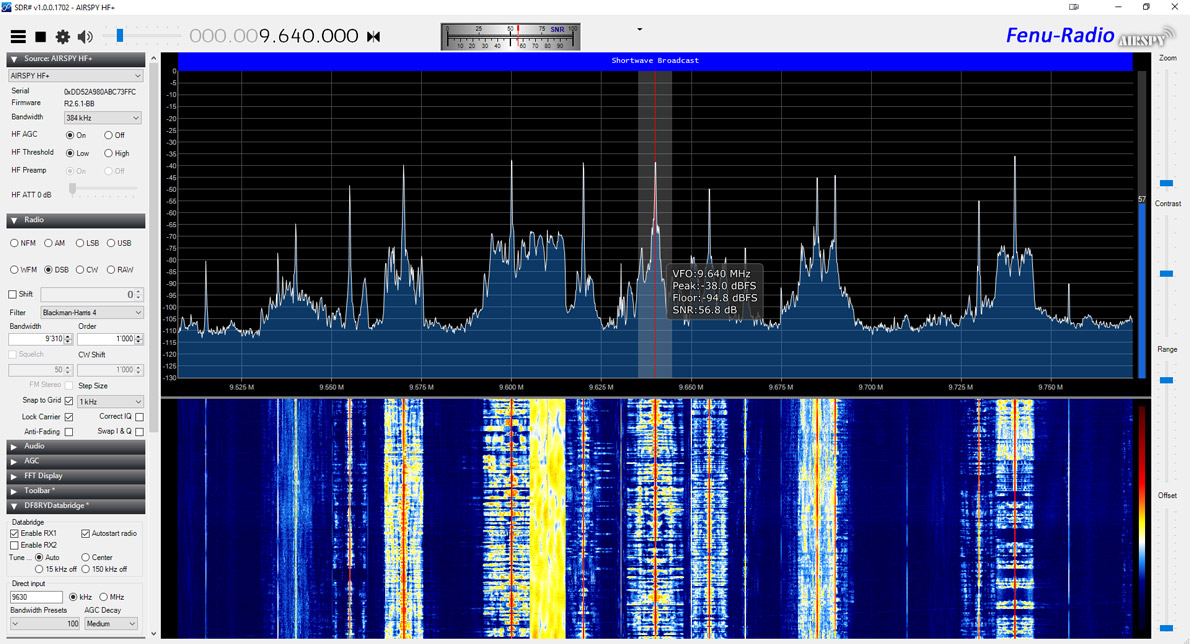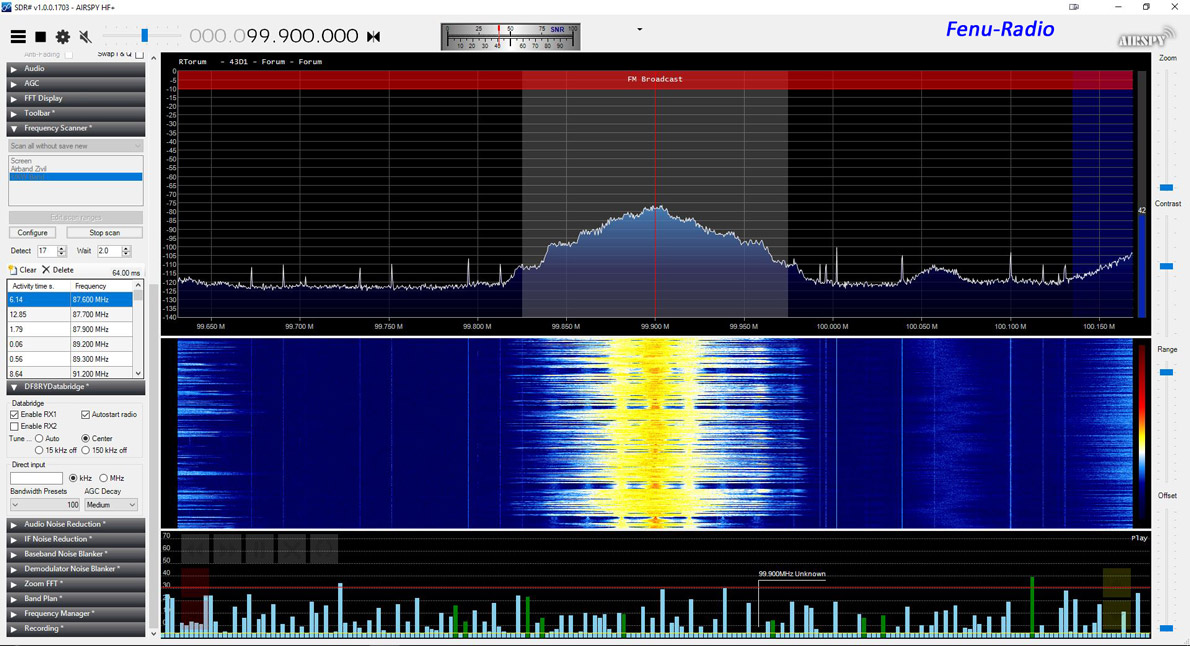|
Airspy HF+ Discovery
In early 2018, Airspy introduced the HF + Dual Port, which quickly became a successful tuner-based SDR. The reception were excellent for the low budget price range. Now the successor appears! The "Airspy HF + Discovery".
Youssef Touil, owner
of Airspy and developer of SDR receivers and their software, did not
rest on the success, but developed the HF+ Discovery. Why a new
development after such a short time? A conversation with Youssef
brought clarity. HF+ Discovery "Prototype" At
the beginning of May 2019 I was one of the first testers to receive
a specimen of the HF+ Discovery "Prototype". When I opened the very
small package, I was amazed not bad! The device is super small and
feather-light. It's the size of a matchbox. The housing is no longer
made of aluminum, but of plastic. Also, only one SMA antenna
connection is available. The first action was of course connect and
listen. Because the HF+ Discovery was developed from the HF+ Dual
Port, many things could be taken over, including the firmware. So
just connect and go. The lower images show the boards of the two versions. The differences in the board layout are clearly visible.
It took a good three months for the official version of the HF+ Discovery to be ready. Then the firmware has been improved and expanded several times. Youssef Touil responded quickly to hints and quickly provided optimized firmware. Among others, SDR # introduced the "low-IF" mode. This mode allows the DC peak of tuner-based SDRs to be in the center of the spectrum, off-centering some Khz. With this mode, the receiver also needs less power. Functional principle of HF + Discovery The HF+ Discovery is like the HF+ Dual Port from the same house, a tuner-based SDR. This means he works with mixer, PLL circuit and VCO. The signal passes through the antenna coming from a switch that switches the required high and low pass filter (preselector) depending on the set frequency range. Thereafter, the signal is mixed in a special mixer and then digitized. It then passes through the DSP and is then passed on to the PC via the USB interface. There it can be used with various programs such. SDR # and SDR Console V3 and HDSDR are demodulated and edited. However, the operation of the novel mixer differs from the usual mixers of RTL tuners. The HF+ Discovery works with a so-called "Polyphase Harmonic Redjection Mixer". This new multi-phase harmonic suppression mixer allows the Airspy HF+ Discovery to deliver outstanding low-budget performance. Block diagram of the HF+ Discovery
Software for the HF+ Discovery The HF+ Discovery can be controlled with various programs under Windows. The default program is SDR#. This is the best way to control it. It does not need installation and is "plug and play". Also very good programs are the SDR-Console-V3 and HDSDR. These two have to be installed. The SDR-Console-V3 already contains the ExtIO "airspyhf.dll". With HDSDR the ExtIO "airspyhf.dll" has to be downloaded from the website and copied to the program folder. Test conditions in stationary operation Both devices were tested with their standard programs. The HF+ Discovery and the Winradio G33DDC were connected via the antenna distributor Elad ASA-15 with the Elad ASA-62, which allowed the choice between the antennas. The active dipole Datong AD-370, the Stampfl active dipole, the Reuter Crossloop, a passive 2.75m long vertical rod antenna and a superdiskone were used for the test. The tests were done at different times of day to cover every band and situation as close as possible to practice. Both devices were individually adjusted for comparison to give their full performance. Only the bandwidth filters and the mode were always set the same. As always, I started at the lowest frequency at which a station was received. At 18.3Khz the marine station HWU from France was active. The direct comparison to parallel running Winradio G33DDC, made no differences. Neither in level, signal clarity nor in the noise behavior. I've checked the whole VLF band at various times of the day and night, without any major differences between the two SDR's. Nevertheless, the HF+ Discovery was positive. Not a single overloading phenomena from the long or medium wave was heard on VLF. A very good performance for such a small device. It continued on the long wave. Because of local disturbances of robotic lawnmowers and strong impulses of a nearby pasture fence not necessarily a listening pleasure. In terms of noise performance, sensitivity and overload resistance, both devices equaled. Apart from tonal differences. SDRSharp has a less high-pitched playback, which seems a bit more relaxed. Nevertheless, the Winradio had a slight advantage, which is due to the control software. The Noiseblanker (NB) of Winradiosoftware was able to filter out the pasture fence impulses of the nearby pasture fence almost completely. The NB of SDRSharp only approach way. Unfortunately, the setup procedure of the SDSharp NB is quite complex. There are some slider very carefully to use. The medium wave was not so much disturbed and left during the day to the receipt of RAI-1 to 999Khz. Very quiet and noisy from both receivers in about the same quality record. At night, the HF+ Discovery could also play its qualities and allowed very good reception even weak stations between the sometimes very strong stations. Above the medium wave to about 1.7MHz, many pirate stations from the Netherlands, Greece, Serbia, etc. are to be received. The HF+ Discovery was also able to receive what the reference device received. Often with less noise with slightly better SNR. Then it was already in the direction of shortwave. The big problem of the low-budget receivers was the poor overload strength due to the many, sometimes very strong summed signals on the shortwave. Unfortunately, most of the low-priced SDRs have never been preselected, mostly for cost reasons. Without exception, these devices had major problems with the usual hobby- antennas. They overload very quickly, which made serious reception on long, medium and short waves rather difficult. Here is the HF+ Discovery the big exception. He has, despite its small dimensions, a built-in preselector. This consists of several low and high pass filters. The difference is noticed quite fast. On the whole shortwave the reception was almost like the Winradio G33DDC. With increasing frequency on the shortwave, the noise floor usually decreases. At quiet frequencies, e.g. at 10051Khz, where Gander-Volmet sends from Canada, the HF+ Discovery receives better than the Winradio G33DDC. Thanks to its high sensitivity and low self-noise, Gander-Volmet can only be heard and understood with the HF+ Discovery. After intensive search I found a few mixed products just below the 31m band. These came from Radio Romania which sends in the 31m band and here partly with S9 + 50dB to receive. With switching to Manual Gain and reduce the sensitivity, you can eliminate the unwanted signals while still retaining the same signal/noise ratio (SNR). Apart from that, I could not detect any further unwanted signals over the entire frequency range. Up to 30 MHz, the HF+ Discovery receives as well as the G33DDC. Sometimes even with better SNR. To describe all situations here, I would have to write sore my fingers. That's why I made some audio comparison shots. These say more than the written word. You can make yourself a picture and judge for yourself. Audio comparisons Differences between the receivers can be best determined with audio comparisons. Of course, this always depends on the settings of the respective receiver. Both receivers were accordingly adjusted for the best possible reproduction. Only the bandwidth filters and the modulation type were always set the same. The appropriate station was chosen carefully so that it was as constant as possible to receive over the recording time, so you can also judge the differences. That sometimes took several attempts. Most audio comparisons are from stations just above the noise floor. I therefore recommend to use a headphone while listening to the audio comparisons. Second 0 - 15: HF+ Discovery Second 15 - 30: Winradio G33DDCThe short-test in portable operation The HF + Discovery was designed primarily for portable use on passive antennas. So I took the time to do a short test outdoor, although "portable" is not my passion. As antenna served a simple wire with 12.5m length. So I drove out into nature with notebook, Discovery and a piece of wire. It quickly became clear that HF + Discovery worked very well with passive antennas. The reception was extremely quiet. The SNR was almost as good as the active antennas at home, if not better. With its gain control you can set the HF + Discovery optimally. Depending on the reception situation, the AGC (automatic gain control) or the manual control can be used to adjust the parameters in order to get the best possible SNR (signal / noise ratio). Reception on FM/VHF The HF + Discovery still offers the reception range from 60Mhz to 260Mhz. This area is separated by two bandpasses. 60-118Mhz and 118-260Mhz. That makes in particularly interesting for airband freaks. At no time have I detected unwanted signals from the FM band in the airband field. With a plug-in, a frequency scanner can be activated, with which the flight radio range and also all other ranges can be scanned. Of course, the FM reception is also decoded in stereo. If the station broadcasts RDS, it is automatically detected and decoded. Below a picture of an FM scan.
Conclusion: The Airspy HF + Discovery delivers a head to head race with one of the best SDR! And he can keep up. Striking is the very low noise, which ensures a relaxed listening. In some situations, he outperformed the Winradio G33DDC in terms of low noise and sensitivity. On usual hobby antennas, it delivers exceptionally good reception on VLF, long, medium and shortwave with minimal overloading symptoms. Also the VHF / VHF range gave good results. With its preselection and sophisticated software, Airspy offers with the HF+ Discovery the best tuner-based SDR for shortwave listening for little money. A small drawback is the hard to adjust Noiseblanker SDRSharp what the nearby pasture fences could not filter properly from the audio. The "Airspy HF+ Discovery" is a real find!
posted: 06.08.2019
|

.jpg)
.jpg)
.jpg)
.jpg)

.jpg)
.jpg)
.jpg)








